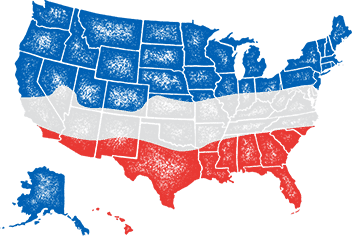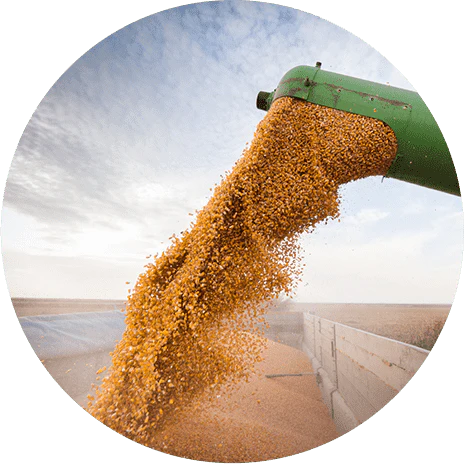
- When to plant:
- Fall, Winter
- Fertilizer:
- Varies
- Seeding rate:
- 150 lbs. per acre
- Overseeding rate:
- 90 lbs. per acre
- Seeding depth:
- 1/2 inch
- Ideal ph:
- 4.5 - 6.0
- Gmo:
- No
- Inoculant needed:
- No
- Coated or raw:
- Raw
- Lifecycle:
- Annual
- Climate zones:
- Cool Season, Transition Zone, Warm Season
Hancock's Buck Tale Oats are a new, improved variety of oats over the Buck Forage Oats and have a great potential for forage, grain, conservation tillage, and wildlife in the southeast USA. Buck Tale Oats have a dual use – performing well in both grain and forage trials. **Buck Tale Oats are treated with insecticides for storage purposes**
Product Information
- Application or Use: Cattle Forage, Livestock Grazing, Cover Crop, Erosion Control, Hay Production, Food Plot
- Germination Time: 5 - 7 days, under optimal conditions
- Growing Locations: Warm Season, Transition Zone, Cool Season
- Height: 2 - 3 feet
- Sunlight Requirements: 8+ hours, full sun for best results
- Advantages: Winter hardy, a drought resistant oat designed to provide more tender growth for a longer interval of time.
- When to Plant: Recommended planting time is fall and winter when night time temperatures are consistently below 65 degrees.
Product Details
- New and improved variety
- Quick, weed-suppressing biomass
- Early-season vigorous growth
- Low-cost, reliable fall cover
- Very early maturing
Product Information
Oats are an extremely attractive addition to any food plot that is grown in the cooler months. This is also a popular choice for hunters that like to plant cereal grains such as grain rye. Deer can visit plots of oats for a larger amount of time but the first two months after germination are the most attractive time for deer. Oats planted in food plots for deer can be planted with legumes such as clover or peas and brassicas such as turnips, radish, kale or rape.
Oats are a cool-season annual grass that is a cost effective, reliable fall cover crop and has been used for many years. Oats are quite an adaptable and affordable crop that provides many benefits to farmers. Some of these benefits include: forage, weed suppression, erosion control, etc.
Oats prefer soils that are well drained and moderate fertility. Oats also grow best when the soil pH is 4.5-6. For maximum cover crop benefit, oats should be planted six to ten weeks prior to any frost.
Oats mature in approximately 60 days, and they can help prevent soil erosion in the short planting windows. Oat may prove especially valuable as a winter-long cover. Typically, oats winterkill with hard frosts and then they leave a thick residue. This provides a great soil-protecting mulch and insulator if planted with an overwintering crop like Alfalfa.
*Product packaging may appear different than what is pictured.
Oats can be either broadcasted or drilled with good success. Drilling the oats will provide the best results thought. If you are drilling the oats – drill them to a depth of ½ to ¾ inch. When drilling, the seeding rate should be 80-100lbs per acre and broadcasted at a rate of 90-150lbs. Oats are planted in the fall for optimal germination and growth.
When choosing to start a new lawn, remove old vegetation by using a de-thatcher, power rake or tiller to kill the existing vegetation. Rake or drag the area to remove debris and dead grass for a clean area. Ensure the soil is leveled and loosened to allow the seed to have good soil contact once spread on a clean seed bed.
If you have an area with heavy weed coverage, we recommend starting fresh by killing and removing the existing vegetation. If you choose to use chemicals, herbicides or fertilizers, you must check with the product's manufacturer prior to planting new seed to ensure the proper waiting period.
When overseeding an existing area, mow your lawn at the lowest setting and bag the clippingsx. Rake or drag any areas that have dead thatch or debris.

Seed Quality
Hancock Seed is dedicated to delivering the best seeds possible to our customers. Hancock Seed grows and harvests many of our products, and we acquire the majority of the rest from other family farmers.
All these seeds are processed, packaged and shipped from Hancock Farm. This helps us ensure that our high standards are met. Unlike much of the competition, we refuse to sell you a seed that was not gathered during the last harvest. You will always receive fresh product from Hancock.
Every seed we grow comes with 40 years of experience behind it...you can rest assured that all of our products are cultivated in a method that assures its potential for growth.

Your cart ( 0 )

Hancock's Buck Tale Oats are a new, improved variety of oats over the Buck Forage Oats and have a great potential for forage, grain, conservation tillage, and wildlife in the southeast USA. Buck Tale Oats have a dual use – performing well in both grain and forage trials. **Buck Tale Oats are treated with insecticides for storage purposes**
Product Information
- Application or Use: Cattle Forage, Livestock Grazing, Cover Crop, Erosion Control, Hay Production, Food Plot
- Germination Time: 5 - 7 days, under optimal conditions
- Growing Locations: Warm Season, Transition Zone, Cool Season
- Height: 2 - 3 feet
- Sunlight Requirements: 8+ hours, full sun for best results
- Advantages: Winter hardy, a drought resistant oat designed to provide more tender growth for a longer interval of time.
- When to Plant: Recommended planting time is fall and winter when night time temperatures are consistently below 65 degrees.
Product Details
- New and improved variety
- Quick, weed-suppressing biomass
- Early-season vigorous growth
- Low-cost, reliable fall cover
- Very early maturing
Product Information
Oats are an extremely attractive addition to any food plot that is grown in the cooler months. This is also a popular choice for hunters that like to plant cereal grains such as grain rye. Deer can visit plots of oats for a larger amount of time but the first two months after germination are the most attractive time for deer. Oats planted in food plots for deer can be planted with legumes such as clover or peas and brassicas such as turnips, radish, kale or rape.
Oats are a cool-season annual grass that is a cost effective, reliable fall cover crop and has been used for many years. Oats are quite an adaptable and affordable crop that provides many benefits to farmers. Some of these benefits include: forage, weed suppression, erosion control, etc.
Oats prefer soils that are well drained and moderate fertility. Oats also grow best when the soil pH is 4.5-6. For maximum cover crop benefit, oats should be planted six to ten weeks prior to any frost.
Oats mature in approximately 60 days, and they can help prevent soil erosion in the short planting windows. Oat may prove especially valuable as a winter-long cover. Typically, oats winterkill with hard frosts and then they leave a thick residue. This provides a great soil-protecting mulch and insulator if planted with an overwintering crop like Alfalfa.
*Product packaging may appear different than what is pictured.
Oats can be either broadcasted or drilled with good success. Drilling the oats will provide the best results thought. If you are drilling the oats – drill them to a depth of ½ to ¾ inch. When drilling, the seeding rate should be 80-100lbs per acre and broadcasted at a rate of 90-150lbs. Oats are planted in the fall for optimal germination and growth.
Instructions
When choosing to start a new lawn, remove old vegetation by using a de-thatcher, power rake or tiller to kill the existing vegetation. Rake or drag the area to remove debris and dead grass for a clean area. Ensure the soil is leveled and loosened to allow the seed to have good soil contact once spread on a clean seed bed.
If you have an area with heavy weed coverage, we recommend starting fresh by killing and removing the existing vegetation. If you choose to use chemicals, herbicides or fertilizers, you must check with the product's manufacturer prior to planting new seed to ensure the proper waiting period.
When overseeding an existing area, mow your lawn at the lowest setting and bag the clippingsx. Rake or drag any areas that have dead thatch or debris.


















